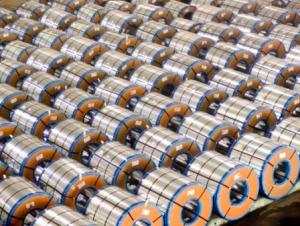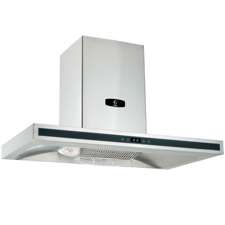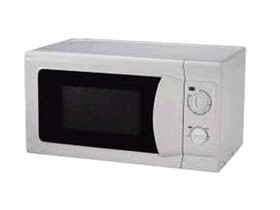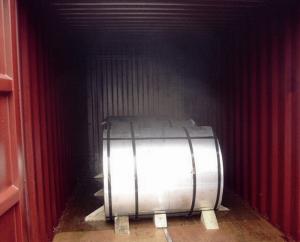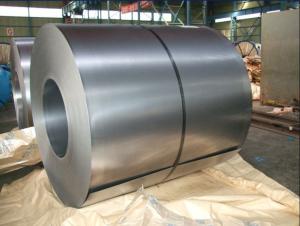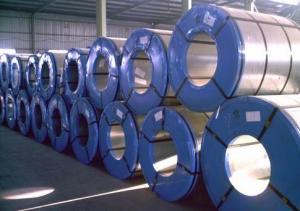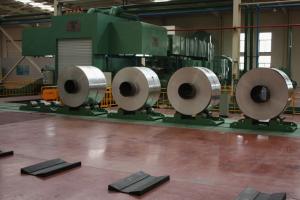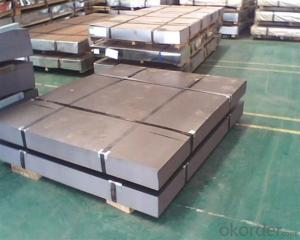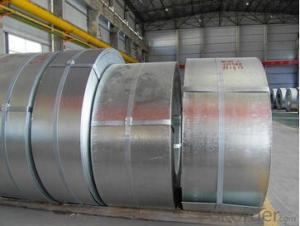Matt Finish Cold Rolled Steel-JIS G3141 SPCC-4
- Loading Port:
- Tianjin
- Payment Terms:
- TT OR LC
- Min Order Qty:
- -
- Supply Capability:
- 4000吨 m.t./month
OKorder Service Pledge
OKorder Financial Service
You Might Also Like
SPECIFICATION
1) Capacity: about10,000 ton per month for steel strip/tape product
2) Thickness: from 0.20mm to 3.5mm, all available.
3) Width: from 15mm to 600mm, all available.
4) Grade: Q195, SGCC, DX51D
5) Coil weight: from 50kg to 7000kg, all available.
6) Coil ID: 100mm - 508mm
7) Coil OD:500mm-1300mm
9) Tensile strength: 28.1-49.2kgf/mm2
10) Zinc coating weight: Min. 60g/m2, double side
11) Spangle: regular spangle, minimized spangle, zero spangle
12) Surface treatment: chemical passivating treatment, oils,passivating oils
13) Min trial order 5ton each thickness, 1 x 20' per delivery
14) Components: C%≤ 0.07, Si%≤0.03, Mn% ≤ 0.50, P% ≤ 0.025,S% ≤ 0.025, Alt% ≥ 0.02
It is the basedmaterial for galvanized steel coil and pre-painted galvanized steel coil. It iswidely used in light industry for making tank, furniture, pipe, refrigerators,washers, freezer plate, air conditioner, micro-wave oven, water heater,soot-such machine, electric rice cooker, electric roaster oven, dryers andautomobile etc. In the other application industries, it’s mainly used forenameling, office furniture, burglarproof door, electronic element, fastenerbattery, hardware, automotive fitting etc.
Eye to sky package: Anti-damp paper inside fullwrapped with plastic film, iron sheet outside on wooden pallet in 20 feetcontainer with 25mt.
- Q: All the steel straps that secure my deck and stair 6x6 posts to the concrete piers have some rust on them. Had bought a rust reducer to spray on them and repaint. As I went to do this I found that one of them is on its last legs, with the steel rusted through and bubbling up all up the sides of the straps. Since this is the end post on a row of 3 deck support posts, I was thinking of removing as much rust as possible, then paint with Rustoleum and cover lower post with something to keep water away from post and pier in the future? Was thinking of something removeable so I could check on it for further rusting. What do you folks with building experience think of this? Thanks.
- If these steel straps are rusting through and on their last legs, a coat of paint is going to be cosmetic at best. Replace these straps with new ones. The originals were either very poorly galvanized, or you live someplace with a very corrosive environment. In any event, paint can't save this sort of thing. Steel brackets serve a real purpose, and after they're weakened, they can't do that anymore. How would your home hold up in an earthquake, for example? What you're proposing doesn't sound safe.
- Q: How are steel coils used in the production of marine vessels?
- Steel coils are used in the production of marine vessels primarily for their strength, durability, and corrosion resistance. These coils are shaped and formed into various components such as hulls, decks, and bulkheads, providing a sturdy framework for the entire vessel. By utilizing steel coils, marine vessels gain the necessary structural integrity to withstand harsh marine environments and ensure the safety and reliability of the vessels.
- Q: There's this huge community of steelians (steelites?) in my town. Has anybody heard of this Dr. Steel?
- Here are twenty that I grew up listening to, such a lot of them within the loved ones auto in which I had 0 manage over what used to be performed. But I nonetheless love each one in every of them to nowadays... Sea Cruise- Frankie Ford Walk Don't Run- The Ventures Don't Worry Baby- The Beach Boys Bus Stop- The Hollies These Boots Are Made For Walking- Nancy Sinatra I Saw Her- Mamas Papas A Taste Of Honey- Herb Alpert Everybody's Talking At Me- Nilsson Superstar- The Carpenters Indian Reservation- Paul Revere The Raiders Come And Get It- Badfinger Tell Me Something Good- Rufus Come And Get Your Love- Redbone Higher Ground- Stevie Wonder Waterloo- ABBA How Long (Has This Been Going On)- Ace The Hustle- Van McCoy More More More- Andrea True Connection Shining Star- Earth, Wind Fire Got To Give It Up- Marvin Gaye
- Q: What are the environmental considerations associated with steel coil production?
- The environmental considerations associated with steel coil production include the extraction of raw materials, such as iron ore and coal, which can lead to habitat destruction and air/water pollution. The manufacturing process involves energy-intensive operations and emissions of greenhouse gases, contributing to climate change. Waste generated during production, such as slag and dust, can also have negative impacts on the environment if not properly managed. Additionally, the transportation of steel coils over long distances can result in carbon emissions and increase the overall environmental footprint of the product.
- Q: What is the size range of steel coils?
- The size range of steel coils can vary depending on the specific application and industry. Generally, steel coils come in a wide range of sizes to accommodate different needs. The width of steel coils can range from as narrow as a few inches to as wide as several feet. Similarly, the thickness of steel coils can vary from very thin gauges, such as 0.005 inches, to thicker gauges exceeding 0.5 inches. The length of steel coils is typically determined by the manufacturing process, but it can be customized to meet specific requirements. Overall, the size range of steel coils is quite extensive, allowing for flexibility and adaptability in various industries, such as automotive, construction, and manufacturing.
- Q: How are steel coils used in the manufacturing of elevator components?
- Steel coils are used in the manufacturing of elevator components as they provide the raw material for producing various parts such as brackets, frames, and structural supports. These coils are processed through cutting, bending, and shaping techniques to create the necessary components that ensure the safe and efficient operation of elevators.
- Q: What are the different types of steel coil slitting processes?
- There exist various steel coil slitting processes, each with its own advantages and considerations. Listed below are some of the most common methods: 1. Rotary slitting: This traditional and widely-used process involves a circular blade that rotates to cut through the coil. Rotary slitting is known for its precision and ability to produce narrow strips, making it suitable for a wide range of applications. 2. Loop slitting: This method requires the coil to pass through a loop before being cut. It enables high-speed processing and can handle thicker materials. Loop slitting is commonly applied in heavy-duty applications and with large coils. 3. Drag slitting: Also referred to as shear slitting, this process utilizes a stationary blade to pull the material and make the cut. Drag slitting is ideal for thinner materials and provides a high-quality edge finish. 4. Crush slitting: By pressing the material between two rollers, crush slitting achieves the desired cut. It is commonly used for delicate materials that require a gentle cutting action. This method ensures clean cuts and minimizes burrs. 5. Laser slitting: As implied by its name, this process employs a laser beam to cut through the coil. Laser slitting provides high precision and can handle various materials. It is especially advantageous for specialty steels and thin strips. When selecting the appropriate method, it is crucial to consider factors such as material thickness, coil size, and required strip width for each type of steel coil slitting process. Additionally, factors like cost, speed, and edge finish should also be taken into account to determine the most suitable process for a specific application.
- Q: Why cold rolled stainless steel sheet is lower than cold rolled stainless steel coil?
- If it is calculated in accordance with the board, then his sales price should be 1*1*2*7.93*10=158.6 yuan / ZhangIf it is calculated according to the volume (assuming that the sales price is consistent), 0.9*1*2*7.93*10=142.7 yuan / ZhangSimilarly, a piece of stainless steel, if sold at the same price, leads to different prices. So in order to let both plate or rolling up to the same price, the price will be lower than the plate volume price, so the same with the price of the goods..The specific proportion of their conversion, can calculate the price of the goods in accordance with the principle of.
- Q: what is the history of steel and how did they start making it, i need a link or an answer that is five paragraphs long. plus i need examples of subtitles about the history of steel. i am doing this for a science project and hope that someone can help me out.thanks
- There's wide history of steel, you can read different tutorials online to know more about it. Check wiki for detailed information.
- Q: What are the different types of steel coil edge treatments?
- In the manufacturing and processing of steel coils, various steel coil edge treatments are employed. These treatments serve to improve edge quality, protect against damage, and facilitate the handling and processing of the coils. Some of the prevalent types of steel coil edge treatments are as follows: 1. Mill Edge: The steel mill provides this standard edge treatment, which is the raw edge of the steel coil generated during the hot rolling process. The mill edge is typically sharp and may exhibit some irregularities. 2. Slit Edge: Slit edge treatment involves slitting the coil to the desired width and subsequently processing the edges to eliminate any burrs or unevenness. Compared to mill edge coils, slit edge coils have smoother edges. 3. Deburred Edge: The deburring process removes any sharp or rough edges from the coil using specialized equipment or techniques, resulting in a smoother and safer edge. Deburred edges find common use in applications where safety and handling are of utmost importance. 4. Rounded Edge: Rounded edge treatment entails rounding the edges of the coil to minimize the risk of damage during handling and processing. This treatment is frequently employed in applications where the coil must be uncoiled or fed into machinery without incurring any damage. 5. Beveled Edge: Beveling involves chamfering or cutting the edges of the coil at an angle. Beveled edges are utilized in applications where easy insertion, joining, or welding of the coil is required. The beveling process also enhances the strength and durability of the edge. 6. Sheared Edge: Shearing is a cutting process that employs high-pressure blades or scissors to cut the coil to the desired width. Sheared edge treatment yields a clean and straight edge, devoid of burrs or irregularities. It is commonly employed in applications that necessitate precise dimensions and a smooth edge. These are merely a few examples of the various steel coil edge treatments commonly employed in the industry. The selection of edge treatment depends on specific application requirements, such as handling, processing, safety, and aesthetics.
Send your message to us
Matt Finish Cold Rolled Steel-JIS G3141 SPCC-4
- Loading Port:
- Tianjin
- Payment Terms:
- TT OR LC
- Min Order Qty:
- -
- Supply Capability:
- 4000吨 m.t./month
OKorder Service Pledge
OKorder Financial Service
Similar products
Hot products
Hot Searches
Related keywords
